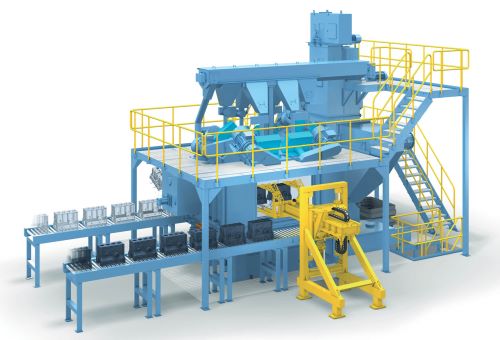The Process
With the IDS inside airblast machine, workpieces are blasted in a cycle process. The workpieces (e.g. cylinder heads and engine blocks) are transported to the machine with roller conveyors. Before blasting, they are centered on the roller conveyor.
The machine works in tandem with a robot which is picking parts off a roller conveyor and transporting them into the control station (fakir test). There the parts are checked whether the channels to be blasted are open. If one of the openings is not free, the robot waits for an operator check. The operator is to select whether the parts are to be checked again via the robot's operating device or to be ejected. If the test is faultless, the parts are placed in the blast chamber.
Inside the blast chamber, the robot arm moves the workpiece towards the rows of airblast nozzles that then blast the internal surfaces of bores and channels – either from the outside or by dipping into the workpiece. The robot gripper is sealed with a diaphragm seal.
After the blast process, the robot arm gently sways the part to let abrasive run off and then puts it to an emptying station before placing it back onto a roller conveyor. The parts are transported via roller conveyor to the inspection area and afterwards to machining.
The modular cell design allows the easy extension of the machine with a row of robot arms working to a blast chamber each. This ensures production increases can be accommodated, while the lance-mounted exchangeable blast nozzles can be adapted and upgraded to keep pace with changing process needs. Additionally, the compact design allows the installation on a minimum space requirement.
As any equipment designed for automotive, the IDS is optimised for maximum uptime, with manganese liners inside the blast chamber reducing wear and clever abrasive logistics ensuring a constantly perfect abrasive mix.



